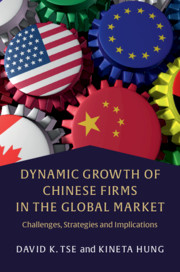Book contents
- Dynamic Growth of Chinese Firms in the Global Market
- Dynamic Growth of Chinese Firms in the Global Market
- Copyright page
- Contents
- Figures
- Tables
- 1 Introduction
- 2 China’s Economic Rise and Global Footprints of Chinese Firms
- 3 Globalisation of Chinese Firms Using Existing Paradigms
- 4 Globalisation of Chinese Firms Using New Paradigms
- 5 Challenges and Failures
- 6 Product Images and Market Acceptance of Chinese-Made Products
- 7 Corporate Social Responsibility
- 8 Managing National Image
- 9 China’s Technological Competence, Trade Relations, and Economic Co-operation
- 10 Holistic Conclusion through a Futuristic Lens
- Index
- References
6 - Product Images and Market Acceptance of Chinese-Made Products
Published online by Cambridge University Press: 05 February 2020
- Dynamic Growth of Chinese Firms in the Global Market
- Dynamic Growth of Chinese Firms in the Global Market
- Copyright page
- Contents
- Figures
- Tables
- 1 Introduction
- 2 China’s Economic Rise and Global Footprints of Chinese Firms
- 3 Globalisation of Chinese Firms Using Existing Paradigms
- 4 Globalisation of Chinese Firms Using New Paradigms
- 5 Challenges and Failures
- 6 Product Images and Market Acceptance of Chinese-Made Products
- 7 Corporate Social Responsibility
- 8 Managing National Image
- 9 China’s Technological Competence, Trade Relations, and Economic Co-operation
- 10 Holistic Conclusion through a Futuristic Lens
- Index
- References
Summary
Achieving acceptance of Chinese-made products by developed markets is a major challenge faced by Chinese firms. This chapter examines the perception of China and Chinese-made products in overseas markets and its psychological resistance, paying special attention to the unfavourable made-in-China image. In addition to recognizing the evidence-based negative perceptions, the psycho-social motivations that may give rise to a biased perception against made-in-China are also examined. The chapter then discusses emerging studies that uncover that culturally open and world-minded consumers are less susceptible to these attitudes, pointing to ways that the bias against Chinese brands and products can be revised. Finally, the chapter discusses the success of some Chinese firms (e.g., Alibaba) and their favourable spillovers on perceptions of Chinese firms and their products.
Keywords
- Type
- Chapter
- Information
- Dynamic Growth of Chinese Firms in the Global MarketChallenges, Strategies and Implications, pp. 103 - 122Publisher: Cambridge University PressPrint publication year: 2020



